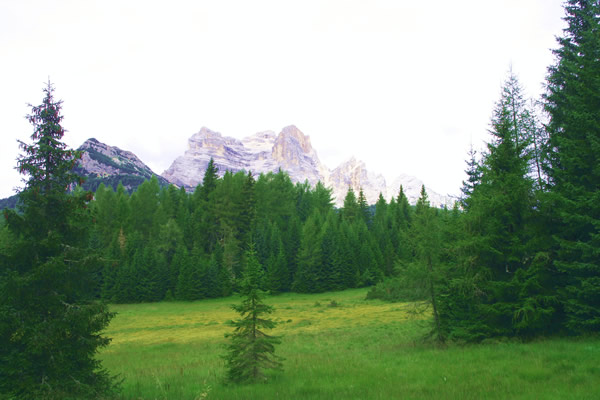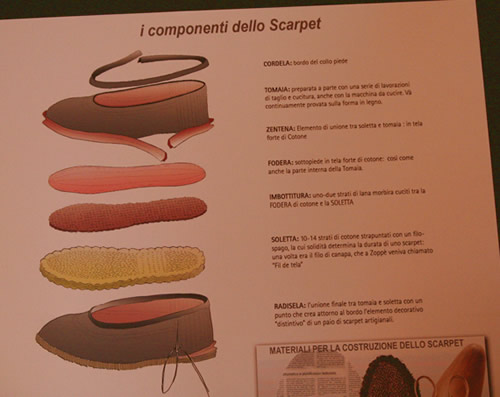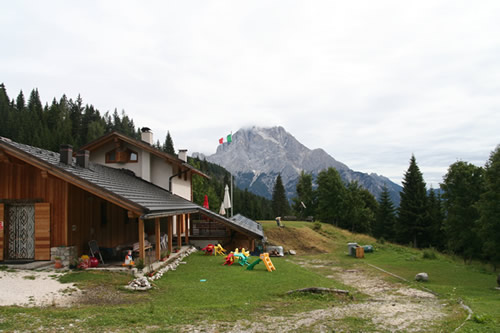Slow Travel in the Dolomites
of Italy
Article and photos by Lara
Giavi
 |
|
Walking towards the Becco di Cuzze
in the Dolomites.
|
Slow travel is a way to go back to
historical and cultural origins, to the way people used
to move from one place to another while immersing themselves
in nature and getting back in touch with a more authentic
or traditional way life. There are areas in the
Dolomites
that offer a view into all aspects of rich local tradition
in relatively unspoiled nature. I wish to explore
one unique area in order to be your host and guide to a
traditional world not offered by some modern resorts
geared more towards mass tourism.
When you hear words such as Bondì!
(Good morning) or che fasto? (What are you doing?),
you know you are somewhere in the Dolomites.
Pink twilight views, a climbers’ paradise,
Tyrolean villages, stylish resorts …there is far more to
the Dolomites — nestled within Italy between the Austrian
border to the north and the Venetian plain to the south — than
such stereotypical images that certainly have an understandable
allure.
The Cadore area, in the heart of Belluno
Dolomites, has a great deal to offer travelers seeking traditional
cuisine, culture and customs. At the same time, the region
does not lack the panoramic views and facilities offered
by other, more modern, mountain resorts.
Visiting the Traditional Village
of Zoppè di Cadore
Last summer we visited Zoppè di Cadore,
a small village at an altitude of 1,426 meters (4,678 feet),
somewhat secluded from other villages. And this was not
our first visit.
Life has not always been that easy up
there, since in the past seasonal emigration was common
out of economic necessity. For example, skilled ice cream
makers from Belluno Dolomites emigrated to other European
countries or across the Ocean, selling their exquisite gelato
artigianale (homemade
ice cream).
We really appreciated the ethnographic
museum, featuring many aspects of past life and folk
traditions. Much space is dedicated to the Scarpet (typical
footwear used in the past) manufacturing techniques.
During summer fairs, it is often possible to see local
women hand-sewing Scarpets using a traditional technique.
Scarpets can also be purchased in shoe shops, but these
are made in a different and unique way.
 |
Exposition about the Scarpet
at the ethnographic museum in Cadore.
|
Scarpets were also worn by the Ladins,
the early inhabitants of Rhaetic origins of the Dolomites
area. Nowadays, people can be seen wearing traditional clothes
during village fairs or folk events.
Most people in Zoppè and other Dolomites
areas speak Ladin,
a recognized minority language that is taught in some schools,
along with Italian. Ladin has connections to Latin and Romansch,
one of the languages spoken in Switzerland. There are variations
of Ladin, or dialects, which vary from place to place. The
Union dei Ladign de Zopè has published its own Ladin dictionary.
If you are interested in the Ladin language, the main seat
of the Istituto
Ladin de Dolomites is in Borca di Cadore.
The ethnographic museum offers a great
deal of space to the history of charcoal burners, as well.
Poor families could derive a small income with the production
of charcoal from wood. Charcoal was primarily sold to fusine (forges)
in the Valley of Zoldo in order to fuel fire required when
melting iron extracted from local mines. Some resourceful
people wished to hand down the tradition, so almost every
summer a Poiat (coal cellar) is built on the outskirts
of Zoppè. The construction of the cellar requires skill
and patience, since the fire must be fueled night and day.
On the last day, a village fair takes
place in which sacks of charcoal can be purchased, as well
as DVDs and other material connected with Ladin culture.
We had lunch there and spent time watching women hand sewing
the traditional Scarpet.
The European
charcoal burners association in Germany aims to promote
traditions in European regions where charcoal burners’
and similar ancient works in their original form are
preserved.
Exploring Areas Surrounding Zoppè
The mountain road that leads to Vodo
di Cadore (see travel information below) made us feel as
if we were traveling back in time. Silence, nature in its
unspoiled form, a fairy tale like atmosphere, and respect
for soldiers who monitored the Cadore valleys were among
the images and feelings evoked when we explored this area.
We also absorbed the sights of imposing trees, green meadows,
and picturesque Tabià (rural barns used for sheltering
hay and cattle).
If you wish to explore the area, you
might leave the car near the Rifugio (mountain
hut), which lies along High Route 3 (Alta via n. 3). It
serves meals and offers information about the surrounding
area. From the Rifugio, walk about 1.5 km back to Zoppè
along the road: an easy trek will lead you to Becco di Cuzze,
where the remains of some Great War trenches and artillery
emplacements can be visited. Another easy walk along CAI
(Italian Alpine Club) path 493 will take you to Palù de
Serla, a peat-bog (torbiera),
covered with colorful droseras.
 |
| Mount Pelmo seen from the Rifugio Talamini. |
Food Specialities from
the Dolomites
At this point one may want
to try from some of the most typical Dolomites
dishes, which include:
- zuppa di porcini (mushroom
soup)
- zuppa di ortiche (nettle
soup)
- ravioli stuffed
with game (venison, for example)
- polenta e capriolo (maize
porridge with roe deer meat)
As a dessert gelato artigianale
con frutti di bosco (homemade ice cream
with local soft fruit, raspberries for example)
is a must.
The many varieties of grappa (a
clear and strong alcoholic drink made of grapes)
that comes flavored with local herbs such as juniper
or with other fruits.
For an inexpensive eating you
can try Alimentari (produce stores), selling among
other things:
- locally produced honey
and apples
- formaggio di malga (semi-cooked
or semi-hard cow or goat’s cheese made in shepherds’
huts)
- Schiz (full-fat
cows’ milk cheese shaped in square moulds)
- puccia con speck del
Cadore (traditional bread with smoked
ham)
If you have cooking facilities
you may want to try the following recipe:
Gnocchi Seasoned with
Walnuts and Cheese
Ingredients
for 4 people
- 500 grams stale
bread
- 300 grams malga
cheese
- 100 grams walnuts
- 100 grams butter
- 100 grams grated grana cheese
- 3 eggs
- 1 glass of milk
- 1 small onion
- 3 tablespoons
flour
- parsley
- a pinch of salt
|
Directions
Cut the onion into
small slices and brown in oil.
Cut bread and malga
cheese into small cubes.
Open eggs and place
them in a big bowl together with the bread,
malga cheese, onion, parsley, milk, flour,
and salt.
Mix everything and
shape the mixture into small gnocchi,
using a spoon to help mold (images and
videos are available online to illustrate).
Boil the gnocchi for
15 minutes in plenty of salt water.
When gnocchi are ready
they will rise to the surface. For best
results do not put all gnocchi into the
water at exactly the same time.
Season the gnocchi
with grana cheese, crushed walnuts, and
melted, browned butter. Serve hot. |
|
Transportation To, From, and Around
Zoppè
- Getting to Zoppè by public transportation
is relatively cheap and offers you the opportunity to
meet local people, but does require time and patience.
- If you wish to do so, you may catch
a train from
Padova or Venice to Belluno.
- A local
bus from Belluno train station will get you to
Forno di Zoldo, where you will have to catch another
bus of the same company up to Zoppè.
- If you are travelling by car, the
journey via Forno di Zolfo is faster. Road conditions
are good but in winter you must be able to use snow chains.
- A less known mountain route from
Vodo di Cadore will take you there passing through isolated
and scenic woods. If you choose this option, be sure
that the route is not closed due to heavy snowfalls or
bad road conditions.
Accommodations
For those not wishing to stay in up
market hotels, Zoppè is the right place to visit, since
accommodations are mainly found in apartments rented by
local people.
Look out for “Civetta — Accoglienza — appartamenti” when
you arrive or in your online research.
Eating Out and Other Practical Information
A Locanda in the village serves
traditional dishes. An Alimentari store (supermarket)
sells food and toiletries. Other facilities include the
Town Hall (with an internet cafe), a bank, a church, the
post office, a coffee bar, and more.
Dolomites Tourist Information:
Visit Dolomites
For more information on the Slow Travel
Movement in Italy from an Italian perspective, including
many itineraries and articles around the country, visit the
Movimento Lento: The Slow Tourism Network.
Best Time to Go
Public transport runs all year round.
If you wish to go trekking or experience folk fairs, the
best time to go is during the spring or summer since most
events take place at that time. Of course, travel peak season
always involves more visitors as well, but that does not
diminish much of the unique experience.
With a keen interest in languages
and other cultures, Lara Giavi has backpacked
in all continents while between jobs while based in Tuscany.
|
